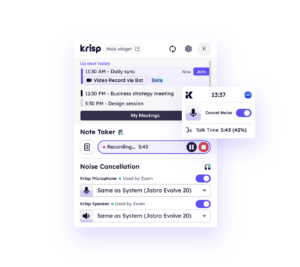Business meetings are the cornerstone of thriving organizations. Whether face-to-face or virtual, these gatherings serve as crucial chances for strategizing, resolving issues, and aligning team members.
In this comprehensive guide, we explore meeting best practices and the key elements to successful meetings — from setting clear objectives to conducting meetings with precision.
Whether leading a multinational corporation or a small startup, mastering how to conduct a business meeting is essential for organizational success.
What is a Business Meeting?
A business meeting is a structured gathering where individuals come together to discuss and make decisions related to various aspects of the organization. These professional meetings serve multiple purposes, including:
- Strategizing for future projects: planning and setting goals for upcoming initiatives – big or small.
- Resolving current issues: addressing and finding solutions to existing problems or misunderstandings.
- Aligning team members: ensuring everyone is on the same page regarding company objectives, values, and directions.
- Fostering collaboration: building a sense of community and teamwork within the organization.
Participants might include internal team members, stakeholders, clients, or other relevant parties, depending on the specific objectives of the meeting.
Formats of Business Meetings
In traditional meeting best practices, business meetings were held in person within office settings. However, with the advent of modern technology and the rise of remote work, meetings can now be conducted in various formats:
- In-person meetings – face-to-face interactions in physical office spaces or other locations.
- Virtual meetings – using video conferencing tools like Zoom or Microsoft Teams for real-time interactions between participants in different locations.
- Hybrid meetings: one of the meeting best practices and a combination of in-person and virtual participants.
- Conference calls – audio-only meetings conducted via phone or internet-based calling services.
- Asynchronous communication: while not technically a corporate meeting format, tools like Slack, email, or project management platforms facilitate ongoing discussions. Information sharing doesn’t require real-time interaction, which can sometimes reduce the need for formal corporate meetings.
Integral Elements of Great Business Meetings
Regardless of the format, effective business meetings hinge on several key elements:
- Clear objective – defining the purpose and goals of the meeting.
- Well-defined agenda – outlining the topics to be discussed and the order of discussion.
- Robust communication skills – facilitating open and constructive dialogue to ensure productive outcomes.

Business meetings can significantly contribute to an organization’s overall efficiency and success. the latter is more than possible if specific goals are set, the right participants are invited, and effective communication is promoted.
How to Conduct a Business Meeting
In this section, let’s discuss meeting best practices and some critical steps to ensure a successful business meeting:
Prepare in Advance
Thorough preparation is the cornerstone of an effective business meeting. Ensure all necessary materials, such as agendas, reports, and presentations, are ready and distributed to participants before the company meeting. This allows everyone to come prepared and informed, contributing to a more efficient and productive discussion. By preparing in advance, you set the stage for a focused meeting where all attendees are on the same page.
Set Clear Objectives
Begin the business meeting by clearly stating its primary purpose and desired outcomes. This helps focus the discussion and ensures everyone understands the meeting’s goals. Clear objectives guide the conversation and provide a benchmark for measuring the meeting’s success. Without well-defined goals, meetings can easily drift off course, wasting time and resources.
Welcome Participants
Start the corporate meeting with a brief welcome and introductions if necessary. Acknowledge the presence of key participants and thank everyone for their time and participation. A warm welcome sets a positive tone and fosters a collaborative atmosphere. It also helps participants feel valued and engaged right from the start.

Review the Agenda of the Business Meeting
Go over the agenda to outline the structure and flow of the business meeting. Highlight the key topics to be discussed and allocate specific times for each item to keep the meeting on track. Reviewing the agenda ensures that all participants know what to expect and can prepare accordingly. It also helps to manage time effectively, ensuring that all important topics are covered.
Encourage Open Business Discussions
Encourage participants to share their thoughts and ideas while ensuring the conversation remains on topic. Use active listening skills and address any questions or concerns promptly. An open discussion fosters creativity and problem-solving, but it’s important to steer the conversation back on track if it starts to veer off course. Creating a space where participants feel comfortable sharing their insights can lead to more innovative solutions and better decision-making.
Assign Action Items and Other Deliverables
Based on the discussion, clearly define participants’ tasks and responsibilities. Make sure everyone knows what is expected of them and set deadlines for completion. Assigning clear action items is one of the overall meeting best practices. The former ensures accountability and helps to drive progress. It’s essential to follow up on these tasks to ensure they are completed in a timely manner.
Summarize Key Points
At the end of the corporate meeting, summarize the main takeaways and decisions made. This reinforces understanding and ensures everyone is aligned on the next steps. A concise summary helps to solidify what was discussed and decided, reducing the risk of misunderstandings. It also provides a clear reference point for future actions and follow-ups.
Follow Up
After the business meeting, send all participants a summary or meeting minutes. Include the key points discussed, decisions made, and action items assigned. This helps maintain accountability and keeps everyone on track. Follow-up communication is essential for ensuring that the momentum from the meeting continues and tasks are completed. It also provides a record of the meeting that can be referred back to if needed.
By following these steps, you can conduct a focused, organized, and productive business meeting that will lead to meaningful and actionable outcomes for your organization. Effective meetings are crucial to successful business operations, fostering collaboration, innovation, and strategic decision-making.
Getting the Most Out of Your Business Meetings With Krisp
As discussed above, clear and effective communication is critical for successful business meetings. Whether held in-person or virtually, meetings are where key decisions are made and strategies are developed.
However, background noise and environmental distractions can often compromise the quality of these interactions, leading to misunderstandings and wasted time. This is where Krisp’s AI Meeting Assistant steps in to revolutionize the business meeting experience.

AI Meeting Assistant – A Comprehensive Solution
Krisp’s innovative approach addresses multiple aspects of corporate meeting management, enhancing productivity and efficiency. Let’s examine each component to understand how it optimizes business meetings:
Pioneering Noise Cancellation Technology
- Uses AI-driven technology to filter out unwanted background noise and echo,

- Enables uninterrupted, focused discussions,
- Works in various environments, from busy offices and cafes to home settings,
- Easily integrates with popular meeting platforms like Zoom, Microsoft Teams, Google Meet, etc.
- Minimizes distractions, leading to more efficient decision-making processes.
Highly Accurate Real-Time Transcriptions
- Generates transcriptions during the meeting with 96% accuracy,
- Ensures precise, real-time meeting notes that are saved automatically in one unified place (as you can notice below,)
- Offers an accurate record of conversations, perfect for capturing detailed business discussions,
- Supports multiple languages, enhancing global collaboration.
Intelligent Meeting Summaries and Action Items
- Goes beyond note-taking by generating detailed meeting summaries,
- Offers customization options for action items or comprehensive highlights,
- Simplifies the process of sharing meeting notes with teammates or stakeholders,
- Enhances the distribution of important information, promoting better teamwork and understanding.
By integrating these components, Krisp’s AI Meeting Assistant addresses common pain points in business meetings.
A recent study found that professionals attend 62 meetings per month, with 31 hours spent in unproductive meetings. Krisp’s solution aims to significantly reduce this wasted time by enhancing meeting quality and efficiency.
5 Common Types of Business Meetings
Now that we know meeting best practices let’s quickly review the types of business meetings and what to expect.
Business meetings come in various forms, each serving a specific purpose and requiring a tailored approach to maximize effectiveness. Understanding the different types of business meetings and their objectives can help ensure that each gathering is productive and meaningful.
1. Informative Meetings
Informative meetings are designed to disseminate important information to a group of participants. These corporate meetings typically involve one or more presenters who share updates, insights, or knowledge on specific topics relevant to the attendees. The primary goal is to ensure that everyone has the necessary information to perform their roles effectively. Informative meetings can cover a range of subjects, from new company policies and industry trends to training on new tools and procedures. By providing clear and comprehensive information, these meetings help keep all team members informed and aligned.
2. Project Status Update Meetings
Project update meetings are regular business meetings that keep team members informed about the progress of ongoing projects. These meetings focus on reviewing milestones, discussing upcoming deadlines, and addressing any challenges that may have arisen. By sharing updates, team members stay aligned with each other’s work and responsibilities, fostering a sense of accountability and ensuring that projects remain on track. Project status update meetings help identify potential issues early, allowing for timely interventions and adjustments to project plans.
3. Problem-Solving Meetings
Problem-solving meetings are focused on addressing and resolving specific issues within the organization. These meetings involve a systematic approach to analyzing the problem, brainstorming potential solutions, and developing action plans to implement the chosen solution. Effective problem-solving meetings encourage open dialogue and collaboration, allowing participants to explore different perspectives and identify the root causes of issues. By fostering a collaborative environment, these meetings can lead to innovative solutions and improved processes, ultimately enhancing organizational performance.
4. Decision-Making Meetings
One of the common types of business meetings is decision-making meetings. The latter are assembled to make critical decisions that impact the organization. These meetings require thorough preparation, including gathering relevant data, outlining options, and setting clear agendas to facilitate informed business discussions. Effective decision-making meetings involve key stakeholders who can provide valuable insights and contribute to decision-making. The goal is to reach a consensus or make a definitive choice that guides the organization’s future actions. Clear communication and documentation of decisions made are essential to ensure that all participants understand and support the outcomes.
5. Company Announcement Meetings
Company announcement meetings are held to communicate significant news and updates to employees. These meetings can cover a wide range of topics, such as organizational changes, new business strategies, financial performance, or major achievements. The objective is to ensure transparency and inform everyone about significant company developments. These meetings often involve senior leadership and provide an opportunity for employees to ask questions and seek clarification. By keeping the workforce informed and engaged, company announcement meetings help build trust and foster a sense of unity within the organization.
Key Takeaways
To sum up, conducting a successful business meeting involves thorough preparation, clear communication, and effective use of technology.
It is a multifaceted process that requires careful planning and execution. Businesses can ensure productive outcomes by following key steps such as setting clear objectives, welcoming participants, and encouraging open business discussion.
Additionally, incorporating tools like Krisp’s AI Meeting Assistant can further enhance corporate meeting efficiency by minimizing distractions and improving communication. Overall, conducting effective business meetings is essential for driving innovation, making informed decisions, and achieving organizational goals.


